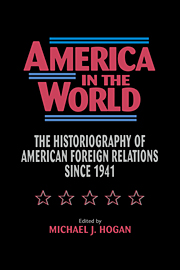Book contents
- Frontmatter
- Contents
- Preface
- The Authors
- Part One The State of the Art
- Part Two The Historiography of American Foreign Relations since 1941
- 6 The Historiography of American Foreign Relations: An Introduction
- 7 A Half-Century of Conflict: Interpretations of U.S. World War II Diplomacy
- 8 The Decision to Use the Bomb: A Historiographical Update
- 9 Origins of the Cold War in Europe and the Near East: Recent Historiography and the National Security Imperative
- 10 Making Known the Unknown War: Policy Analysis of the Korean Conflict since the Early 1980s
- 11 Eisenhower Revisionism: The Scholarly Debate
- 12 John F. Kennedy as World Leader: A Perspective on the Literature
- 13 The Unending Debate: Historians and the Vietnam War
- 14 Complaints, Self-Justifications, and Analysis: The Historiography of American Foreign Relations since 1969
- 15 An Emerging Synthesis? U.S.–Latin American Relations since the Second World War
- 16 Gideon's Band: America and the Middle East since 1945
- 17 The Cold War in Asia: The Elusive Synthesis
- 18 The Power of Money: The Historiography of American Economic Diplomacy
- 19 Coming in from the Cold War: The Historiography of American Intelligence, 1945–1990
- Index
7 - A Half-Century of Conflict: Interpretations of U.S. World War II Diplomacy
Published online by Cambridge University Press: 05 June 2012
- Frontmatter
- Contents
- Preface
- The Authors
- Part One The State of the Art
- Part Two The Historiography of American Foreign Relations since 1941
- 6 The Historiography of American Foreign Relations: An Introduction
- 7 A Half-Century of Conflict: Interpretations of U.S. World War II Diplomacy
- 8 The Decision to Use the Bomb: A Historiographical Update
- 9 Origins of the Cold War in Europe and the Near East: Recent Historiography and the National Security Imperative
- 10 Making Known the Unknown War: Policy Analysis of the Korean Conflict since the Early 1980s
- 11 Eisenhower Revisionism: The Scholarly Debate
- 12 John F. Kennedy as World Leader: A Perspective on the Literature
- 13 The Unending Debate: Historians and the Vietnam War
- 14 Complaints, Self-Justifications, and Analysis: The Historiography of American Foreign Relations since 1969
- 15 An Emerging Synthesis? U.S.–Latin American Relations since the Second World War
- 16 Gideon's Band: America and the Middle East since 1945
- 17 The Cold War in Asia: The Elusive Synthesis
- 18 The Power of Money: The Historiography of American Economic Diplomacy
- 19 Coming in from the Cold War: The Historiography of American Intelligence, 1945–1990
- Index
Summary
No event in U.S. history save the Civil War has assumed the mythic proportions of World War II, or resulted in such a deluge of scholarly as well as popular studies. Historiographical analyses of those scholarly studies, however, are in much shorter supply, especially in regard to U.S. wartime diplomacy. The recent fiftieth-anniversary commemorations of the war, along with the enormous number of publications that have preceded and accompanied those commemorations, make this a particularly appropriate time to provide such an analysis.
In an earlier, 1981 assessment, I noted that the historiography of U.S. diplomacy during World War II possessed characteristics both similar to and different from other areas of intense historical dispute. Major similarities included the large volume of writings, the impact of contemporary concerns on evolving interpretations, and the effect of new schools of thought regarding U.S. foreign relations in general. World War II diplomacy was a unique field, however, in at least two important respects. First, the combination of massive documentary evidence and continued popular interest in the war had already resulted by 1981 in a volume of literature so enormous and so rapidly growing as to merit special mention. Second, although the resulting schools of interpretation reflected to an extent those of U.S. diplomacy in general, they possessed a distinctive quality because of the enormous influence of the Cold War on the interpreters. That influence, I emphasized, had led most historians to analyze World War II diplomacy primarily in terms of its role in the postwar Soviet-American conflict.
- Type
- Chapter
- Information
- America in the WorldThe Historiography of US Foreign Relations since 1941, pp. 166 - 205Publisher: Cambridge University PressPrint publication year: 1996



